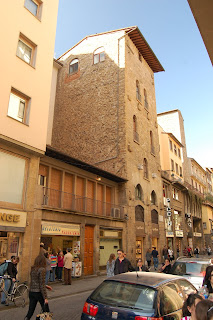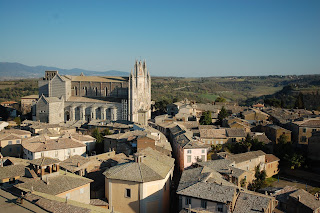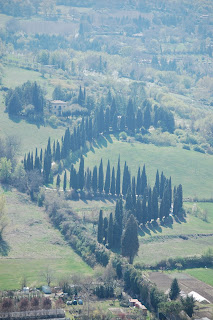_-_WGA10264.jpg) |
| Detail of fresco by Benozzo Gozzoli |
Today, the small town of San Gimignano is known to tourists as "the medieval Manhattan," because it retains several of its towers. In Dante's time, every city's skyline looked like this.
 |
| San Gimignano |
It was because of this that in the year 1250 Florence's short-lived popular government, in an effort to control the arrogance of the magnates, decreed that all private towers be reduced to a height of no more than 29 meters.
As you can see from this depiction of Florence in the 15th century, towers, even shortened, were still very much in evidence. Many of them are there still. Survivors of the 1250 decree, of time and of medieval battles, of modernization and refurbishing, and even of the onslaughts of World War II, it's amazing how many remain.
 |
| Florence, September 1944 |
 |
| Tower in Tarquinia |
I've written a book set in Florence in 1216. That was well before the enforced truncation of the towers. I have a scene where my protagonist and another main character are on a balcony high up one of the towers, watching an altercation taking place below.
That tower still stands - it contains a jewelry store today - but it's an awful lot shorter than it used to be.
 |
| The Amidei tower, now a jewelry store |
I'm not good with picturing distances. Spatial relationships are not my forte. But I had to get some idea of what my characters' experience would have been, and this is how I went about it.
First, I travelled to the setting of my story, to see what I could learn. My tower is very short these days; others are also shorter than they used to be. So, on to other Italian towns nearby, where the governments may not have been quite so diligent.
I've climbed up quite a lot of rather tall towers in various towns in Italy (on the inside, I mean, nothing daredevilish). It's quite safe - these days, they don't let you go up unless there's a modern staircase - but it can be a real workout, and it's not something to get yourself into if you're claustrophobic. Hundreds of steps, steep ones, winding around in a tight spiral.
Also not ideal if you happen to be afraid of heights, which I am (and which my protagonist also is). I keep doggedly climbing the things anyway, though, because they're there, and because I need to understand them, and also because my husband takes amazing pictures from way up there.
But the height does get to me. I've been known to circle the perimeter of the top of a tower in a crouch, sort of a crab-walk, too afraid to stand up (fortunately there was no one else up there at the time). And once I somehow took it into my head that the sinister-looking fellow climber standing near us had a thing about university professors and was going to push my unsuspecting husband over the edge, so I spent that visit keeping myself solidly between Il Signore Sinistro and my oblivious spouse, who was flitting around happily taking pictures. Heights make me a little crazy.
(One very real hazard, by the way, occurs when you're up a bell tower, and you happen to be standing next to the bell, and it comes time to strike the hour. You do not want to experience this. Trust me.)
I think my acrophobia may be the main reason why, even after all those jaunts, I still felt a little unsure about what things would have looked like to my characters, from their perch on high. I never could make myself spend much time actually looking down.
I needed to understand exactly what one could have seen, from the relevant height. I had all those pictures my husband had taken, but he keeps changing lenses, and so things get closer and then farther away again, and it's all very confusing. Also, some of the towers we had been in had been truncated, and others had been rebuilt, and in most cases I wasn't sure exactly how high up we had been.
So I decided I needed a point of comparison.
My first step was to ascertain just how high up my characters would have been. It didn't take long to find out that according to chronicler Giovanni Villani, Florentine towers in their heyday soared to heights of 100 braccia and more.
Great. So (shades of Bill Cosby, for those of you who remember that comedy routine), what's a braccia? The word is the Italian word for "arm," so it's roughly an arm's length. However, it varied from place to place. Apparently a Florentine arm wasn't exactly the same length as a Pistoian arm, for example.
But I was able to learn that a Florentine braccia was 58.36 cm. Just as I was reaching for a calculator, I stumbled across a very useful bit of information: Florentine towers could reach 120 braccia, which equals about 70 meters, which equals about 230 feet.
That was exactly what I needed to know. My characters were in one of the city's taller towers, but not all the way up to the top. They were on a balcony, maybe three-quarters of the way up.
But as I said, I am no good at visualizing distances. What exactly did it mean to be somewhat less than 120 braccia, or 70 meters, or 230 feet off the ground?
Next: to the internet. I went looking for buildings of a comparable height, and I found a few.
 |
| Pyramid of Djoser |
 |
| Palazzo Vecchio |
 |
| Campanile and Duomo |
With all this, I was getting an idea of what my target height looked like from the outside, but I still needed to know what the world looked like from that height. I cast back among my memories for something that would serve.
I do remember one high place, and I remember it well. My grandparents lived in Chicago, on the 16th floor of a wonderful old building. As a child I spent many hours looking out of their windows, watching the life of the city go by. I wasn't afraid to look down then - I was very small, and the world seemed a safe place. I watched the waves on the lake, the traffic on the Outer Drive, the people walking on the sidewalks far below. I saw the city's lights reflected on wet streets when it rained. I know - I actually can remember - what I observed. I know what I could see (colors, shapes, movement) and what I couldn't (clothing details, facial expressions). I know what I could hear, though since it was mostly vehicular noise, this wasn't particularly useful. But the visual part was.
That is exactly what I needed to know. Could it possibly be the case that my memories coincide with the view my characters would have had?
 |
| Riverside Plaza |
I found a floor/height calculator online, but it was incredibly complicated, factoring in interstitial spaces, residential vs. commercial use, lobbies, varying ceiling heights, and more. I didn't have all that information. And then I thought, well, is there any chance that I can find my grandparents' building online? Crossing my fingers, I gave it a try. After all, it's called "The Renaissance," which has got to be a good sign, right?
.jpg) |
| "The Renaissance" |
If the tower my characters were in was 120 braccia (70 meters, 230 feet) and their balcony was, say, three-quarters of the way up, then they'd be at - oh, about 170 feet.
Bingo.
I didn't need to do any formidable calculations. I just needed to go back to my earliest memories. Who knew that when I was watching the cars go by from my vantage point, I was about 90 braccia above ground?
Don't you just love it when that sort of thing happens?
Images in this post: Gozzoli fresco, view of 15th c. Florence, and photo of postwar Florence are in the public domain. Photos of San Gimignano and the Pyramid of Djoser are licensed under Creative Commons Attribution-Share Alike 3.0 Unported license. Photos of Riverside Plaza and The Renaissance are licensed under Creative Commons Attribution-Share Alike 2.0 Generic license. Other photos are our own.




































